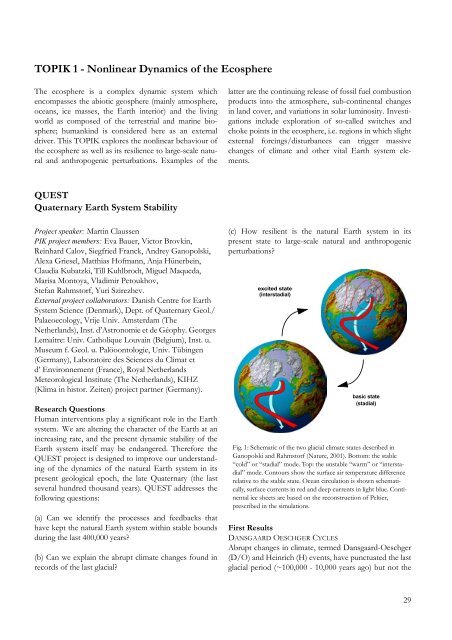PIK Biennial Report 2000-2001 - Potsdam Institute for Climate ...
PIK Biennial Report 2000-2001 - Potsdam Institute for Climate ...
PIK Biennial Report 2000-2001 - Potsdam Institute for Climate ...
You also want an ePaper? Increase the reach of your titles
YUMPU automatically turns print PDFs into web optimized ePapers that Google loves.
TO<strong>PIK</strong> 1 - Nonlinear Dynamics of the Ecosphere<br />
The ecosphere is a complex dynamic system which<br />
encompasses the abiotic geosphere (mainly atmosphere,<br />
oceans, ice masses, the Earth interior) and the living<br />
world as composed of the terrestrial and marine biosphere;<br />
humankind is considered here as an external<br />
driver. This TO<strong>PIK</strong> explores the nonlinear behaviour of<br />
the ecosphere as well as its resilience to large-scale natural<br />
and anthropogenic perturbations. Examples of the<br />
QUEST<br />
Quaternary Earth System Stability<br />
Project speaker: Martin Claussen<br />
<strong>PIK</strong> project members: Eva Bauer, Victor Brovkin,<br />
Reinhard Calov, Siegfried Franck, Andrey Ganopolski,<br />
Alexa Griesel, Matthias Hofmann, Anja Hünerbein,<br />
Claudia Kubatzki, Till Kuhlbrodt, Miguel Maqueda,<br />
Marisa Montoya, Vladimir Petoukhov,<br />
Stefan Rahmstorf, Yuri Szirezhev.<br />
External project collaborators: Danish Centre <strong>for</strong> Earth<br />
System Science (Denmark), Dept. of Quaternary Geol./<br />
Palaeoecology, Vrije Univ. Amsterdam (The<br />
Netherlands), Inst. d’Astronomie et de Géophy. Georges<br />
Lemaître: Univ. Catholique Louvain (Belgium), Inst. u.<br />
Museum f. Geol. u. Palöoontologie, Univ. Tübingen<br />
(Germany), Laboratoire des Sciences du Climat et<br />
d’ Environnement (France), Royal Netherlands<br />
Meteorological <strong>Institute</strong> (The Netherlands), KIHZ<br />
(Klima in histor. Zeiten) project partner (Germany).<br />
Research Questions<br />
Human interventions play a significant role in the Earth<br />
system. We are altering the character of the Earth at an<br />
increasing rate, and the present dynamic stability of the<br />
Earth system itself may be endangered. There<strong>for</strong>e the<br />
QUEST project is designed to improve our understanding<br />
of the dynamics of the natural Earth system in its<br />
present geological epoch, the late Quaternary (the last<br />
several hundred thousand years). QUEST addresses the<br />
following questions:<br />
(a) Can we identify the processes and feedbacks that<br />
have kept the natural Earth system within stable bounds<br />
during the last 400,000 years?<br />
(b) Can we explain the abrupt climate changes found in<br />
records of the last glacial?<br />
latter are the continuing release of fossil fuel combustion<br />
products into the atmosphere, sub-continental changes<br />
in land cover, and variations in solar luminosity. Investigations<br />
include exploration of so-called switches and<br />
choke points in the ecosphere, i.e. regions in which slight<br />
external <strong>for</strong>cings/disturbances can trigger massive<br />
changes of climate and other vital Earth system elements.<br />
(c) How resilient is the natural Earth system in its<br />
present state to large-scale natural and anthropogenic<br />
perturbations?<br />
excited state<br />
(interstadial)<br />
basic state<br />
(stadial)<br />
Fig. 1: Schematic of the two glacial climate states described in<br />
Ganopolski and Rahmstorf (Nature, <strong>2001</strong>). Bottom: the stable<br />
“cold” or “stadial” mode. Top: the unstable “warm” or “interstadial”<br />
mode. Contours show the surface air temperature difference<br />
relative to the stable state. Ocean circulation is shown schematically,<br />
surface currents in red and deep currents in light blue. Continental<br />
ice sheets are based on the reconstruction of Peltier,<br />
prescribed in the simulations.<br />
First Results<br />
DANSGAARD OESCHGER CYCLES<br />
Abrupt changes in climate, termed Dansgaard-Oeschger<br />
(D/O) and Heinrich (H) events, have punctuated the last<br />
glacial period (~100,000 - 10,000 years ago) but not the<br />
29

















